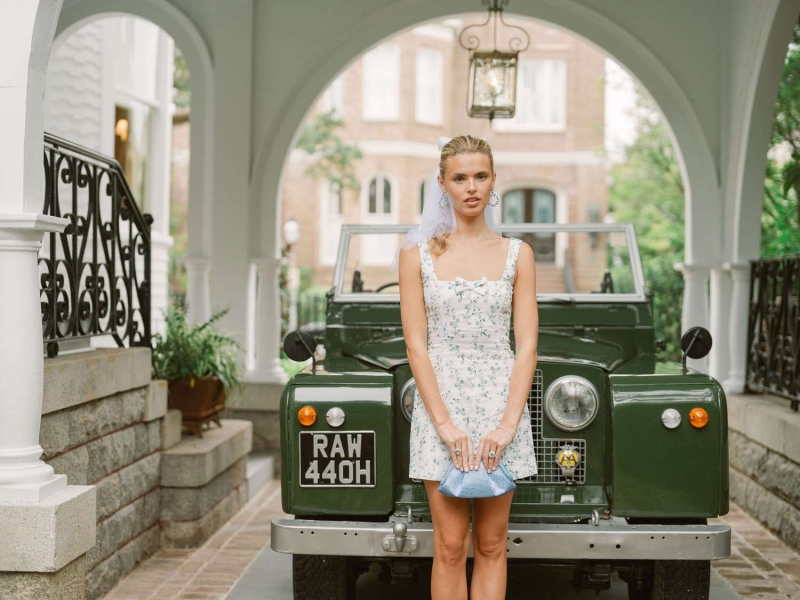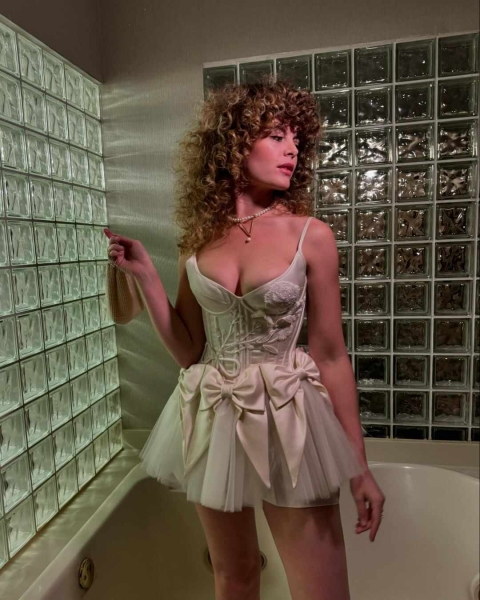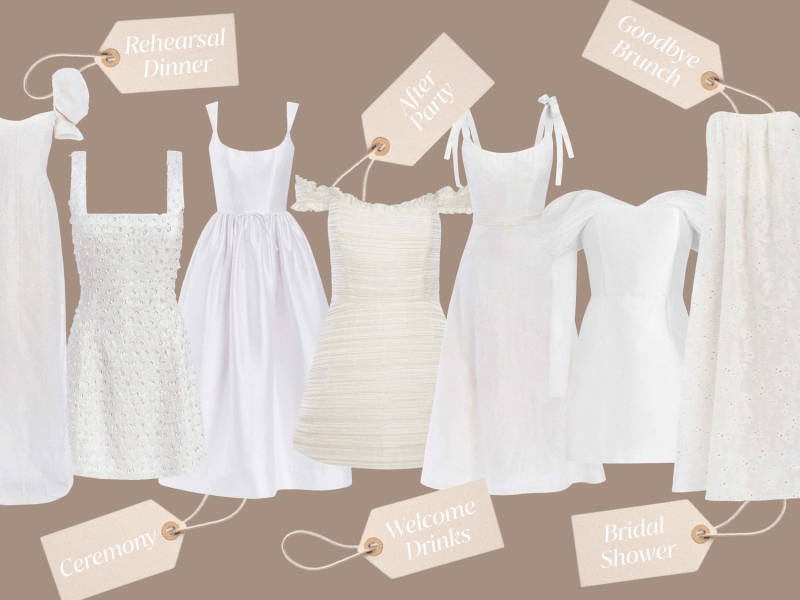How second (and third, and fourth) dresses became the norm in bridal fashion.
If Say Yes to the Dress has taught us anything, it’s that picking out a wedding dress is a sacred ritual.
The feel-good reality show cemented “The Bridal Appointment” as not just a memorable shopping trip but a real-life Cinderella moment in which every bride finds her glass slipper. Episodes usually go like this: The bride arrives with family and friends. We meet some variation of a TLC-approved cast of characters: a discerning matriarch with a sharp tongue, a weepy bridesmaid, and a cheerfully unhelpful friend who loves quite literally every option. The try-ons commence with the help of her fairy godmother (a seasoned Kleinfeld stylist). Our bride deliberates over dress after dress until… she walks out in the one. Everyone cries, even the hard-to-please mother of the bride, and they clink champagne to an afternoon well spent.
This is a feminine bonding ritual, a relatable fairytale, and a fashion fantasy. However, the high stakes of the 2010s Say Yes formula are nothing compared to what goes on today. The 2020s bride is not searching for the one: She scours the Earth for a perfectly crafted bridal wardrobe fit for countless wedding occasions, each more stylish (and expensive) than the last.
It all started with the rise of the “second look.” What began as a wedding trend (in which a bride casts off her ballgown for a shorter, flirtier party dress at the reception) has become less of a wedding novelty and more of a tradition. According to Google Trends, search interest for “reception dress” has increased steadily since the newly-minted Duchess of Sussex Meghan Markle changed into a Stella McCartney gown after her wedding ceremony in 2018. Now, more brides than ever are having their cake (a traditional ballgown) and eating it, too (in a modern mini dress).
The reception dress was just the beginning, though. With each passing wedding season, the fashion bar is set higher. Pre- and post-wedding parties—and the perfect all-white look to match—have become increasingly popular, growing by almost 200 percent since 2020. This includes group honeymoons requiring bridal beachwear, rehearsal dinners with their requisite cream-colored cocktail dresses, and Instagrammable bachelorette trips that would be incomplete without an on-theme rhinestone cowgirl outfit. In short, we’ve reached peak wedding attire. Gone are the days of finding just one dress to say yes to.
Gone are the days of finding just one dress to say yes to.
And the bridal fashion industry is finally starting to deliver options. Both masstige retailers and mall brands have hopped on the trend. Reformation was an early mover in the space, and its popular assortment of sultry, not quite black-tie formal dresses in bridal creams and whites has become something of a brand signature. And this past summer, Abercrombie launched an online wedding shop—featuring the elusive under-$200 white cocktail dress—to great fanfare.
The most recent bridal fashion week in New York saw luxury designers embrace the wedding event dress niche, too. It-Girl favorite bridal line, Danielle Frankel, debuted its first shoe collection and put sharp tailoring and wedding outerwear alongside the usual drop-waist ballgowns. CDFA-nominated Jackson Wiederhoeft continued to riff on corsetry at his namesake brand, offering the signature wasp waist in various lengths, styles, and codes for wedding throwers who want to look snatched at less formal occasions.

But perhaps no designer better understands this phenomenon than Alexandra O’Neill. As the genius behind the editor-loved brand Markarian, she’s been doing the not-so-formal bridal thing for a while now. “We kind of naturally fell into it,” says O’Neill. “People were coming to us looking for their dress for the big wedding day, but then they would be like, ‘Oh, but I also need an afterparty dress—and a welcome party dress, rehearsal dinner dress, goodbye brunch dress.”
O’Neill says Markarian’s “less fussy, easy, and customizable” approach was exactly what bridal clients were looking for, and she hasn’t wavered since launching her first wedding collection in 2019. For spring 2025, the designer doubled down on a signature tea-length bestseller—frequently worn at rehearsal dinners and engagement parties—in new shapes and fabrics. The brand’s recent capsule with bridal tastemaker and e-commerce site Over the Moon features even more wedding event fare, like casual florals and a puffed-sleeve garden dress just begging for a bubbly toast at showers and brunches.
The current wedding dress boom is more than just a passing trend. “It's always been there, but I feel like it's really picked up speed,” O’Neill says, who cites the post-pandemic popularity of the destination wedding as a contributing factor. “It's a nice thing to make sure that there are events every single night for your guests,” she explains, especially when they’ve come a long way. “And if there's an event, there's a dress for it.” Naturally.
Still, that’s not the whole story. Social media’s impact on the wedding industrial complex at large can’t be understated. The ever-expanding wedding event list (with custom outfits, of course) reflects online tide shifts, more than just changing tastes. No matter what platform you’re on, the algorithm loves a wedding dress—the more, the better.
“It’s fascinating how the algorithm seems to favor wedding content, showcasing it to a wide audience,” says Meeka Hossain, an LA-based creator who got married in August. “Everyone loves to see love.” Weddings offer an irresistible combination of relatability and voyeurism that’s For You page bait. More white dresses mean more likes, more shares, and more opportunities for veteran creators and aspiring influencers to go viral (and land lucrative brand deals).

“The term 'bridal celebrity' has truly become a phenomenon,” says Hossain, whose widely-shared wedding mixed Jewish and Bengali traditions in a colorful, fashion-forward affair. “Even two months after my wedding, I still get stopped by strangers wanting to congratulate me.” Plus, if you’re not already internet famous, searching for a wedding dress presents a rare opportunity to build a following.
A viral wedding can also launch a career—just look at how quickly Ivy Getty’s profile rose after her wild and wacky San Francisco extravaganza. She went from socialite to fashion darling almost overnight. All it took was three days of parties, haute couture, one celebrity bridesmaid, a Nancy Pelosi-officiated ceremony, and a healthy dose of memetic desire.
No matter what platform you’re on, the algorithm loves a wedding dress—the more, the better.
If Instagram is about curation, then TikTok is about unfiltered access. And this year’s final boss of “bridefluencers,” Tania Sarin, tried on no less than 60 dresses for her wedding, documenting the entire ordeal for her 300,000 followers. Culminating in a highly-anticipated, multi-video reveal that featured as many twists and turns as an HBO drama, her search for the perfect dress(es)—engagement look, rehearsal outfit, reception dress, getting ready frock, etc.—racked up countless likes and comments throughout her yearlong deliberation. She milked it, to say the least.
The pressure to go all-out on the fashion front is at an all-time high—especially if you spend a lot of time online. For her wedding, Hossain ended up with seven total looks from a host of designers that included a Sabyasachi lehenga (her overall favorite), a Vera Wang wedding gown, and a two-piece Wiederhoeft set for the rehearsal. She managed to find them all despite a short engagement, planning everything in just a few months with a little luck and perseverance.
“As both a content creator and a bride, I definitely felt some pressure to deliver that ‘grand finale’ moment for my audience, especially since I was sharing my entire wedding journey,” admits Hossain. She recalls “hyper-fixating” during a stressful period of her planning process, scheduling meticulous fittings and 1 am Zoom calls to get it all done in time.
Still, the more-is-more approach isn’t necessarily a negative one. For many brides like Hossain, it’s a source of joy and inspiration, not competition or insecurity. “Bengali weddings are traditionally 3 to 5-day celebrations, and in our culture, more is more—more gold, more color, more guests, more food,” explains Hossain. “Everything is done in abundance, which makes it incredibly fun. Initially, I planned on just two outfits: a Western dress for the ceremony and a lehenga for the reception. But as the festivities unfolded, I realized I was missing out on key moments. So, I fully embraced the ‘more the merrier’ approach when it came to my wardrobe.”

Similarly, InStyle's Beauty Director Lauren Valenti harbors no regrets about her wedding fashion choices. "I’ve loved the creative process of playing with different bridal style codes and crafting an array of looks. But it can definitely be a slippery slope; once you start serving, you don’t want to stop," she says. One such serve was a statement-making Wiederhoeft minidress Valenti wore to a bachelorette weekend in Atlantic City, which caused a stir online (and on the InStyle slack channels) after she posted it to Instagram.
"I’ve become a bit obsessive about hunting down special pieces for each event to further the personal style story I’m trying to tell," she adds. "In the beginning, I tried to resist the conventional bridal norms of going all out, but ultimately, I decided to seize the day. Pulling out all the stops in Wiederhoeft was an absolute joy ride." A good dress deserves a good time, so it’s no wonder brides like Valenti are leaning into capital-F fashion for more than just the Big Day. You (hopefully) only get to do this once, so you might as well relish it.
But what happens after the wedding dress boom? There’s joy, fun, and adventure to be had in the search for good bridal fashion, to be sure, and the circular social media one-upmanship of weddings (whether intentional or not) seems to be waxing rather than waning. Plus, while “embrace individuality” and “find your personal style” remain TikTok’s catch-all fashion advice, it’s likely wedding fashion will follow.
Weddings are trending more spectacular, more unique, and more personalized than ever. So, is the future of bridal, once again, more? New events, occasions, and wedding extensions may possibly emerge in the years ahead—although the mind reels at what that might look like. Another (albeit unlikely) alternative is that brides will pair back the pomp and circumstance to counter the multi-day, multi-gown affairs of the past decade. But denying the allure of a weeklong celebration of love (and its many outfits!) seems like an uphill battle.
Either way, the myth of the perfect wedding dress and the shared ritual of looking for it will remain—much like Say Yes to the Dress, which begins its 23rd season later this year. But it’s got some competition.

